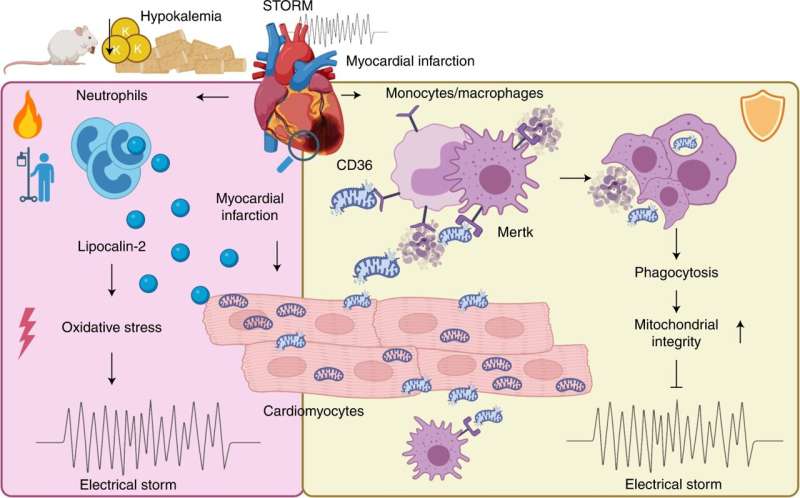Two different white blood cell types play opposing roles in affecting heartbeat irregularities after heart attack

Patients with heart disease are at risk of experiencing a potentially lethal "electrical storm" involving recurrent episodes of a type of irregular heartbeat called ventricular tachycardia (VT).
Electric shock therapy is used to treat VT following a heart attack, but unfortunately, options to prevent VT recurrence are limited.
New research led by investigators at Massachusetts General Hospital (MGH) reveals that two different white blood cell types influence VT in the heart, suggesting that treatments that influence these cells may help reduce patients' risk of sudden cardiac death.
The work, which is published in Nature Cardiovascular Research, is based on the knowledge that cardiac conditions (such as heart attacks) that increase the risk of VT and other heartbeat irregularities lead to massive changes in the white blood cell populations surrounding the heart.
To study the mechanisms involved, MGH scientists developed a new research model. "It was believed that mice don't get VT after a heart attack, but we discovered a surprisingly simple trick to induce it—feeding mice food with low potassium levels," says senior author Matthias Nahrendorf, MD, Ph.D., an investigator in MGH's Center for Systems Biology, Professor of Radiology at Harvard Medical School, and the Richard Moerschner Endowed MGH Research Institute Chair in Men's Health
"This is a major step forward because now we can study how different white blood cell subclasses influence heart rhythms. It is also clinically relevant because every fifth patient who experiences a heart attack has low blood potassium levels, and these patients are known to be particularly likely to develop heartbeat irregularities, or arrhythmia."
The team's experiments demonstrated that among the different white blood cell types, neutrophils promote VT while macrophages protect against it. "Inflammatory neutrophils give rise to arrhythmia by compromising the electrical function of heart muscle cells called cardiomyocytes," explains Nahrendorf.
"Macrophages, which take up debris, are protective, and deleting them gave rise to electrical storm in mice with low potassium levels who experienced a heart attack. Indeed, these mice were more likely to die from arrhythmia."
The findings indicate that additional research into the roles of white blood cells in arrhythmia could lead to new targeted therapies for irregular heart rhythms.
More information: Jana Grune et al, Neutrophils incite and macrophages avert electrical storm after myocardial infarction, Nature Cardiovascular Research (2022). DOI: 10.1038/s44161-022-00094-w

















